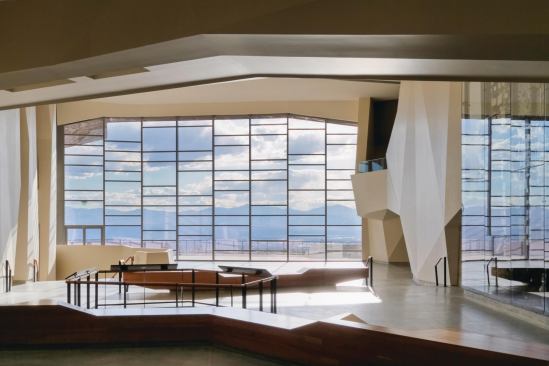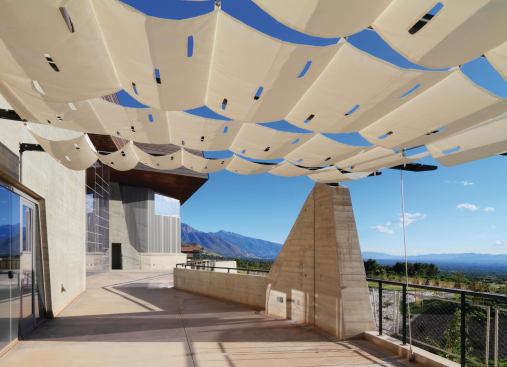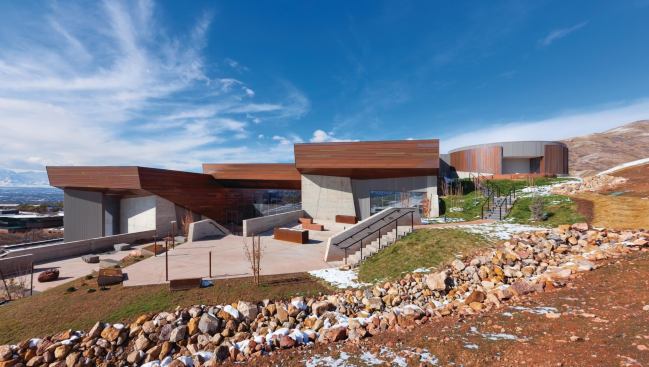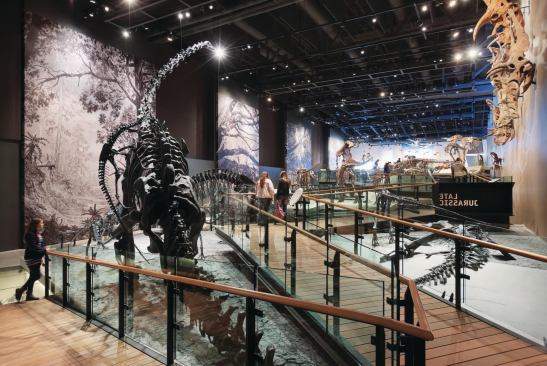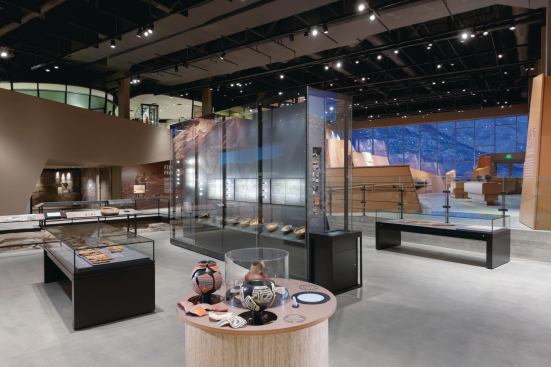©Jeff Goldberg/Esto
When the design team from New York–based Ennead Architects won the commission in 2004 to design the Natural History Museum of Utah in partnership with Salt Lake City–based GSBS Architects, several members of the firm went on a tour of the state to become more familiar with its landscape. One stop that design partner Todd Schliemann, FAIA, remembers most was Range Creek, a hidden valley in the eastern part of the state that is virtually inaccessible, but where archaeological evidence suggests that humans have lived for thousands of years.
“The whole Utah landscape is just stunning, but Range Creek reminded us that natural history isn’t just the story of the land, but how the people engaged it,” Schliemann recalls. “Why did those original inhabitants disappear? Could it have been what we’re about to do with ourselves?”
Opened in November 2011, the new 163,000-square-foot Rio Tinto Center gives the 40-year-old Natural History Museum of Utah a home of its own for the first time (it had previously been located at the University of Utah’s former library building). A public–private partnership with a $103 million budget, the new building allows the institution to display a much wider array from its collection of more than 1.2 million objects.
The old adage of there being two sides to every story seems particularly relevant here. The building itself is divided into two wings, one with laboratories for scientific research and storing the collection, the other an exhibit and interpretive area with everything from dinosaur skeletons to geology exhibits. Of the total square footage, 51,000 square feet is accessible by the public, while 112,000 square feet holds private areas such as the laboratories and conservation spaces. In designing the Rio Tinto Center, Ennead provided experience in designing museums (the Newseum in Washington, D.C., and the William J. Clinton Presidential Center in Little Rock, Ark.) and GSBS brought expertise in sustainability (the Utah Olympic Oval for speed skating from the 2002 Winter Olympics, which was one of the first 12 LEED-certified buildings in the United States). Depending on the time of day and the angle from which it’s viewed, the museum—with its copper-and-concrete façade—can seem either monumental or embedded in the landscape.
It may be telling that the signature architectural space at the museum is a connector. The building’s main hall, known as “the Canyon,” is a wide-open, tall-ceilinged space where professionals and public alike mingle before a multistory glass façade looking out at the basin and the Great Salt Lake.
“Natural history makes you feel very small,” says Don Weinrich, AIA, Ennead’s management partner. “But there’s something very inspiring about being in that scale of space. And there’s the connection to the people intertwined with it.” From the Canyon, a succession of galleries present different narratives about the history of the lake and the land, as well as about Utah’s native peoples, often with views through the glass that correspond to exhibit themes.
Although the stairway leading upward from the lobby’s ticket desk into the Canyon acts as a transitional space from the outside, “We imagine that the entry sequence begins at the bottom of the hill,” Weinrich says. “You catch glimpses of the museum where you confront it, lose site of it, and see it again. The idea of a meander was important. As you’re climbing, you are leaving the city. The building is a little hard to figure out when you look at it at first. It plays scale games. Once you’re inside, the building envelops you.”
The Rio Tinto Center was designed to meet LEED Gold strictures despite its relatively modest budget. A low construction bid in late 2008 allowed the owner to accept alternate features in the bid documents, such as permeable parking-lot pavement and a rainwater-collection cistern. Now the site is irrigated with water collected from the building and parking lot. Rio Tinto is also about 26 percent more energy efficient than if it had been designed to code (which was confirmed by third-party commissioning); this comes in part due to the fact that much of the square footage lies underground. The Canyon relies on radiant heating and cooling alone, reducing the entire building’s dependence on forced air. In addition, not only was more than 75 percent of construction waste recycled, but the building’s steel and concrete are high in recycled content as well. All of the excavated dirt and soil were either kept on site or preserved for reuse.
Teamwork also was important to achieving a sustainable and successful building project, says the museum’s executive director Sarah George. “When we got everyone on board and had started to excavate the site, the contractor brought in a facilitator for us to develop processes to work through difficult challenges,” she recalls. “I thought, this is going to be one of those awful touchy-feely moments—I’m just not one for that. But it was fantastic. We had two or three sessions. The architects and exhibit designers were here, all our contractors and major subcontractors, all the engineers. We started asking, ‘What are the challenges here?’ We worked through decision-making and what problems we saw coming down the pike. Going through that process made a huge difference, I think, in the quality of the final museum. There were raised voices many times through this project. But we all knew what needed to be pushed.”
Brian Libby writes about architecture from Portland, Ore.
Natural History Museum of Utah
Green Team
Acoustics: Shen Milsom & Wilke, smwllc.com
Architect: Ennead Architects, ennead.com—Todd Schliemann, FAIA; Don Weinreich, AIA; Thomas Wong, AIA; Alex O’Briant, AIA; John Majewski, AIA; Megan Miller, AIA; Charmian Place; Katharine Huber, AIA; Joshua Frankel, AIA; Aileen Iverson; Kyo-Young Jin; Apichat Leungchaikul; Thomas Newman; Jarrett Pelletier, AIA
Architect of record: GSBS Architects, gsbsarchitects.com—David Brems, FAIA; John Branson, AIA; Valerie Nagasawa, AIA; Stephanie DeMott; Stacy Butcher; Beccah Hardman; Clio Miller, AIA; Jesse Allen, AIA; Bill Cordray, AIA; Jennifer Still, AIA; Eduardo De Roda; Felissia Ludwig; Cathy Davison; Todd Kelsey; Seth Robertson; Robert Bowman, AIA
Architectural concrete consultant: Reginald D. Hough FAIA
Audiovisual, electrical, and security engineer: Spectrum Engineers, spectrum-engineers.com
Building-envelope analysis: Simpson Gumpertz & Heger, sgh.com
Civil engineer: Stantec, stantec.com
Client, owner: Natural History Museum of Utah, nhmu.utah.edu
Construction manager: Big-D Construction Corp., big-d.com
Cost: Parametrix, parametrix.com
Daylighting and fire engineer: Arup, arup.com
Exhibit planning and design: Ralph Appelbaum Associates, raany.com
Fire-protection, mechanical, and plumbing engineer: Colvin Engineering Associates, colvinengineering.com Landscape architect: Design Workshop, designworkshop.com
Laboratory consultant: Jacobs Consultancy, jacobsconsultancy.com
Lighting designer: Brandston Partnership, brandston.com
Models: Cubic Dimension
Museum graphics consultant: Poulin Morris, poulinmorris.com
Museum conservation consultant: Catharine Hawks
Renderings: Red Square, redsq.us
Retail consultant: Shelley Stephens + Associates
Solar-array analysis: Buro Happold, burohappold.com
Structural engineer: Dunn Associates, dunn-se.com; Leslie E. Robertson Associates, lera.com
MATERIALS
Cabinetwork and custom woodwork, paneling: Fondell Woodwork
Ceilings: Armstrong, armstrong.com; Gordon, gordon-inc.com; Sound Silencer, soundsilencer.com; Tectum, tectum.com
Carpet: Shaw, shawfloors.com; InterfaceFlor, interfaceflor.com
Cladding: Big-D Construction Corp.
Controlled-environment rooms: Harris Environmental Systems, harris-env.com
Curtainwall: EFCO Corp., efcocorp.com
Doors and windows: Blumcraft of Pittsburgh and CR Laurence Co., crlaurence.com; Door Engineering & Manufacturing, doorengineering.com; EFCO; Marshfield Door Systems, marshfielddoors.com; McKeon, mckeondoor.com; Steelcraft, steelcraft.com
Elevators: Otis Elevator Co., www.otisworldwide.com
Energy-management and building-automation system: Johnson Controls, johnsoncontrols.com
Flooring: Daltile, daltile.com; Forbo, forbo.com; Roppe, roppe.com
Furniture: Haworth, haworth.com; Coalesse, coalesse.com; Janus et Cie, janusetcie.com; Stylex, stylexseating.com; Allermuir, allermuir.com; Herman Miller, hermanmiller.com; Mity-Lite, mitylite.com; Steelcase, steelcase.com; KI, ki.com; Nucraft, nucraft.com; WCI, westcoastindustries.com; Martin Brattrud, martinbrattrud.com; Keilhauer, keilhauer.com; Modern Outdoor, modernoutdoor.com
Glass: Viracon, viracon.com
Hardware: Schlage, schlage.com; LCN, lcnclosers.com; Glynn-Johnson, glynn-johnson.com; Von Duprin, vonduprin.com; Ives, iveshardware.com
Lab equipment: ISEC, isecinc.com
Lighting: Bega, bega-us.com; Bruck Lighting Systems, brucklighting.com; Electrix, electrix.com; Erco, erco.com; Lightolier, lightolier.com; Lithonia Lighting, lithonia.com; LSI Industries, lsi-industries.com; Lumenyte Security, lumenyte.com; Lutron, lutron.com; RSA Lighting, cooperindustries.com; Winona Lighting, winonalighting.com; Xenon
Lighting-control systems: Crestron Electronics, crestron.com; Douglas Lighting Control, douglaslightingcontrol.com
Lockers: Penco, pencoproducts.com
Metal panels: Kennecott Utah Copper, kennecott.com; Luvata, luvata.com; Noorda Architectural Metals, noorda.com; Umicore Building Products USA, www.vmzinc-us.com
Moisture barrier: Henry Co., henry.com
Moveable partitions: Modernfold, modernfold.com
Paints and finishes: PPG, ppg.com; Sherwin-Williams, sherwin-williams.com; Benjamin Moore, benjaminmoore.com
Photovoltaics: Sharp Electronics, sharpusa.com; Unisys, weather.unisys.com
Pavers: Green Construction
Plastic laminate: Pionite, pionite.com; Nevamar, nevamar.com; Formica, formica.com; Abet Laminati, abetlaminati.com
Plumbing and water systems: Elkay Cos., elkay.com; Halsey Taylor, halseytaylor.com; Kohler, kohler.com; Rheem, rheem.com; Zurn, zurn.com
Precast concrete: Owell Precast, owellprecast.com
Roofing: Carlisle SynTec, carlislesyntec.com; Vulcraft, vulcraft.com
Seamless acoustical plaster: BASWAphon, baswaphon.com
Solid surfacing: Corian, dupont.com; Innovative Marble and Tile
Stormwater-collection cisterns: Containment Solutions, containmentsolutions.com
Toilet accessories and partitions: All American Metal, allamericanmetal.com; Bobrick, bobrick.com
Window shades: Kirsch, kirsch.com
Wood decking: Fondell Woodwork, fondellwoodwork.com
By The Numbers
Building gross floor area: 163,000 square feet
Number of permanent occupants and visitors: 63 full-time employees and 413 visitors
Percent of the building that is daylit: 50
Total water used (gallons per year): 158,000
Total energy used: 19,442 kBtu
Percent total energy savings: 26.2
LEED rating: Gold (designed to)
Total project cost: $103 million
Data provided by Ennead Architects
